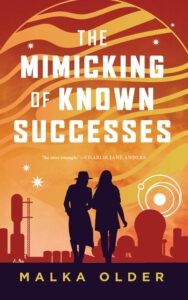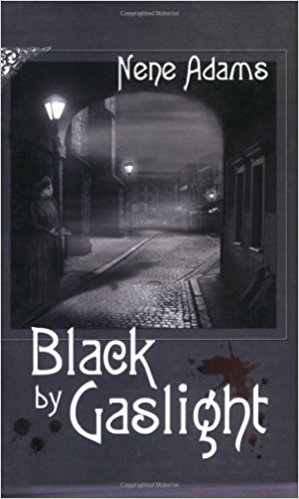Buy this from Bookshop.org to support local bookstores and the Lesbrary!
I love sapphic novellas with an unconventional blend of genre elements—so of course, after reading The Mimicking of Known Successes by Malka Older last year, I eagerly awaited the sequel, The Imposition of Unnecessary Obstacles. I had the sense I’d enjoy it even more as a series, with the chance for the lead investigators, Pleiti and Mossa, to deepen their relationship as they uncover further mysteries in space. I’m pleased to report that I was right.
I can best sum up this series’ mashup of elements with the following detail: At one point in the second book, Pleiti, who lives on a platform attached to the rings of Jupiter, sends a telegram to Io. As a series of standalone mysteries featuring a Holmesian duo, the books’ narrative style evokes the classics. As sci-fi novellas, they explore a future where humans were forced to leave Earth centuries ago due to a climate apocalypse. The compact page count lends itself to tight plots and focused theming, as well as worldbuilding the reader can easily absorb. As a sapphic love story, Pleiti and Mossa’s tale is one of college girlfriends who went their separate ways, only to come back together in a high-stakes environment that reignites their tender partnership.
These elements are tied together through the narration of Pleiti, who works at a university’s Classics department, combing old literature from Earth for details that might help the scientists recreate its ecosystem in a long-term project to make it habitable once more. As the Watson figure in this duo, she records the investigations that Mossa, a high-standards whirlwind of an investigator, drags her along for. The dynamic and style bring in that classic element, but they also make the sci-fi worldbuilding surprisingly approachable—it’s not difficult to justify the narrator going on a brief aside to explain an aspect of humanity’s life above Jupiter when she’s a professor recording the events in an old-fashioned narrative voice. The duo’s banter and history lend a coziness to the books that lighten the post-apocalyptic setting and threats of murder.
With it being easy to disappear over the edge of the platforms and be lost forever, both books so far have dealt with missing person cases, where of course the plot thickens as murder and politics get involved. While I’ll try to avoid major plot spoilers for the second book and for the first book’s mystery, note that as I focus in on the sequel, the rest of the review will necessarily spoil the status quo at the end of the first book re: the main characters and their relationship.
In this second installment, Mossa and Pleiti are investigating the disappearances of a wide array of seemingly unconnected people at the university where Pleiti works. Their investigation takes them all the way to Io, where Mossa was born, and the reader learns more about the history of humans leaving Earth as well as some of the current politics.
In the meantime, though Pleiti and Mossa rekindled their romance in the last book, Pleiti’s yearning remains in full force, as the characters are in a tentative stage of their relationship. Pleiti is still unsure where she stands with Mossa, and the same overthinking that helps her uncover mysteries proves to be counterproductive as she ponders the subtext of their interactions, not aided by Mossa’s intense personality. While investigating, they are able to fall back on their partnership as a source of security, but the hesitancy in their relationship maintains tension even in those quiet moments. This is my favorite stage to read about in a romance, as the characters share fondness, domesticity, and trust, but still have to navigate uncertain waters.
One theme that lends itself well both to the book’s small scale and large scale concerns is the concept of home. Being from Io, Mossa has dealt with the preconceptions people have about her. Meanwhile, having been born on a platform, Pleiti is unmoored both by the openness of space travel and the solidity of a chunk of land. Her awkward attempts to prove to Mossa that she can nonetheless be open-minded about Mossa’s home provide a relatable human element to the bigger questions explored. As humanity as a whole has not been to Earth in centuries, the planet feels unreal to Pleiti, with all the classic Earthen literature she studies taking on a fairy tale quality. The idea of the very goal of her research—a return to a place she’s never been—actually happening in her lifetime thus unnerves her.
This book also touches on themes of classism, as due to the current politics at the university, Pleiti is confronted with the fact that once again a rich man who did horrible things will be venerated. Meanwhile, nobody had noticed over a dozen people disappearing from that same university, in part because many of them had low-paying jobs. At one point, Pleiti wonders with some shame if she had subconsciously thought of a porter as enough of a person to be the subject of a missing person case. This subject is also touched upon on Io, with the discussion of which people had the means to escape Earth to begin with, and some families still being concerned with the supposed status of that lineage.
As the plot unfolds, Mossa and Pleiti must confront the question of why humans impose unnecessary obstacles on their lives, whether it’s within a relationship or the very structure of society. Thankfully, with this book being just a little over 200 pages, there aren’t many obstacles to getting lost in its vision of the future.
Content notes: In addition to the obvious topics related to a climate apocalypse and (off-screen) murder, this book contains one homophobic microaggression and a brief discussion of eugenics.



